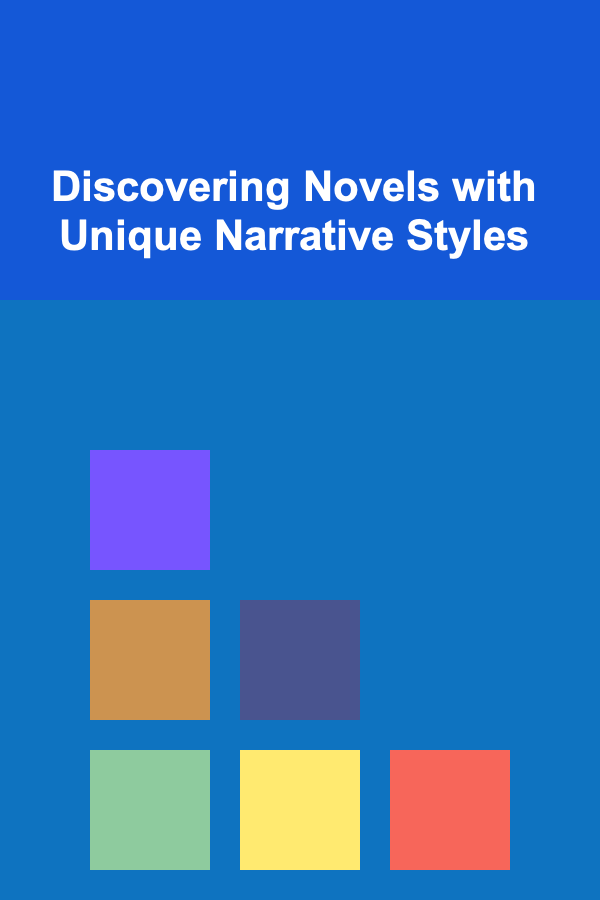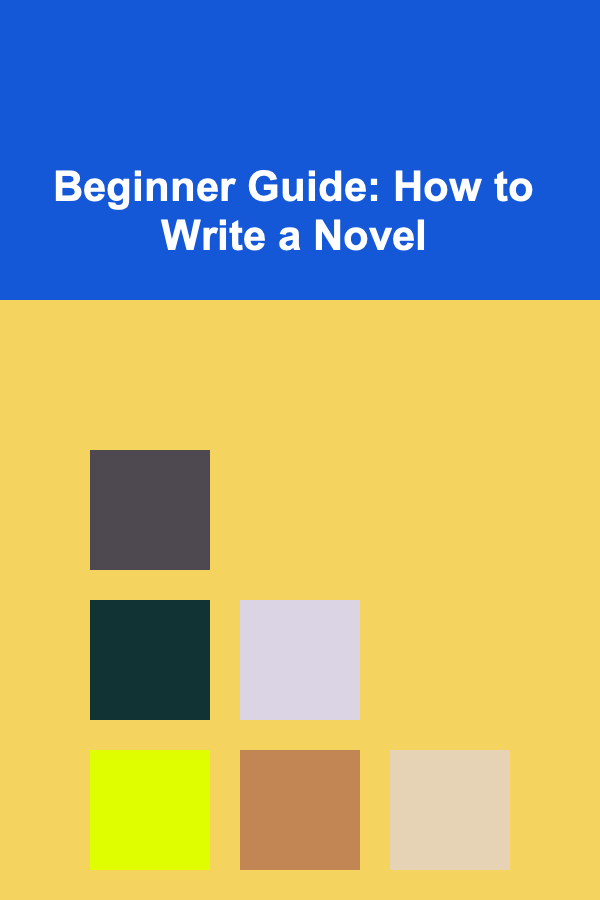
Discovering Novels with Unique Narrative Styles
ebook include PDF & Audio bundle (Micro Guide)
$12.99$10.99
Limited Time Offer! Order within the next:

In a world saturated with stories, finding a novel that truly stands out can feel like searching for a needle in a haystack. While compelling plots and well-developed characters are undoubtedly crucial, it is often the narrative style -- the way a story is told -- that elevates a novel from good to unforgettable. A unique narrative style can offer a fresh perspective, challenge conventional storytelling norms, and ultimately, deepen the reader's engagement with the text. This essay delves into the art of discovering and appreciating novels that boast distinctive narrative styles, providing practical strategies for readers to expand their literary horizons and uncover hidden gems.
What Constitutes a Unique Narrative Style?
Before embarking on the quest for distinctive narrative styles, it's essential to understand what constitutes such uniqueness. Narrative style encompasses a wide range of elements, including:
- Point of View (POV): First-person, second-person, third-person limited, third-person omniscient, and variations thereof. Beyond the basic categories, authors can manipulate POV for specific effects, shifting perspectives mid-chapter, employing unreliable narrators, or even experimenting with multiple narrators who offer conflicting accounts.
- Voice: The distinct personality and tone of the narrator. This includes diction, syntax, rhythm, and overall attitude. A novel's voice can be formal, informal, cynical, optimistic, poetic, or any combination thereof, contributing significantly to the reader's experience.
- Structure: The arrangement of events in the story. Novels can follow a linear chronological order, employ flashbacks, flashforwards, or non-linear timelines. Some authors experiment with unconventional structures, such as epistolary novels (told through letters), fragmented narratives, or novels structured around objects or themes.
- Language: The author's use of words, including figurative language (metaphors, similes, etc.), symbolism, and imagery. A distinctive language style can create a specific atmosphere, evoke emotions, and enhance the overall aesthetic quality of the novel.
- Pacing: The speed at which the story unfolds. Authors can manipulate pacing to create tension, build suspense, or allow for moments of reflection. Short, choppy sentences can create a sense of urgency, while long, flowing sentences can create a more contemplative mood.
- Tone: The overall mood or feeling conveyed by the narrative. Tone can range from humorous and lighthearted to dark and serious, and it can significantly impact the reader's emotional response to the story.
A truly unique narrative style often involves a deliberate combination and manipulation of these elements to create a distinctive and memorable reading experience. It's not simply about employing a single stylistic quirk, but rather about crafting a cohesive and purposeful narrative voice that serves the story's themes and enhances its overall impact.
Strategies for Discovering Novels with Unique Narrative Styles
Finding novels with distinct narrative styles requires a proactive approach. Here are some strategies to guide your search:
1. Explore Literary Awards and Recognition
Literary awards often recognize novels that demonstrate innovation and originality, including those with distinctive narrative styles. Consider exploring the winners and shortlisted titles of prestigious awards such as:
- The Booker Prize: Celebrates the best single work of sustained fiction written in the English language, published in the United Kingdom and Ireland.
- The Pulitzer Prize for Fiction: Awarded for distinguished fiction published in book form during the year by an American author.
- The National Book Award for Fiction: Recognizes outstanding works of fiction written by American authors.
- The Women's Prize for Fiction: Celebrates excellence in fiction written by women in English.
- The Nebula Award for Best Novel: Awarded by the Science Fiction and Fantasy Writers of America (SFWA) for the best science fiction or fantasy novel.
- The Hugo Award for Best Novel: Awarded annually by the World Science Fiction Society (WSFS) for the best science fiction or fantasy novel.
These awards serve as valuable filters, highlighting books that have already been recognized for their literary merit and innovation.
2. Seek Recommendations from Trusted Sources
Personal recommendations can be invaluable in discovering hidden gems. Consider soliciting recommendations from:
- Friends and Family: Engage in conversations about books with friends and family who share your reading interests. Ask them about novels they've read that struck them as particularly unique or innovative in terms of narrative style.
- Book Bloggers and Reviewers: Follow reputable book bloggers and reviewers who specialize in discussing narrative techniques and highlighting unconventional storytelling approaches. Websites like Goodreads, Book Riot, and The Millions offer a wealth of reviews and recommendations.
- Librarians and Booksellers: Librarians and booksellers are experts in their field and can often provide tailored recommendations based on your reading preferences. Don't hesitate to ask them for suggestions of novels with unusual or experimental narrative styles.
- Online Literary Communities: Participate in online literary communities, such as Reddit's r/books or online book clubs. These platforms provide opportunities to discuss books, share recommendations, and discover new authors and narrative styles.
When seeking recommendations, be specific about what you're looking for. Instead of simply asking for "good books," specify that you're interested in novels with unique narrative voices, unconventional structures, or experimental use of language.
3. Explore Different Genres and Subgenres
Expanding your reading horizons to different genres and subgenres can expose you to a wider range of narrative styles. Some genres, such as experimental fiction, postmodern fiction, and magical realism, are particularly known for their innovative storytelling techniques.
- Experimental Fiction: This genre pushes the boundaries of traditional storytelling, often employing unconventional structures, unreliable narrators, and stream-of-consciousness techniques. Examples include works by James Joyce, Virginia Woolf, and William Faulkner.
- Postmodern Fiction: Postmodern novels often challenge established conventions of realism, embracing metafiction, intertextuality, and irony. Authors like Thomas Pynchon, Don DeLillo, and Kurt Vonnegut are prominent figures in this genre.
- Magical Realism: This genre blends realistic settings and characters with elements of magic and fantasy. Authors like Gabriel Garcia Marquez, Isabel Allende, and Toni Morrison have masterfully employed magical realism to explore themes of identity, culture, and history.
- Speculative Fiction (Science Fiction and Fantasy): While not always guaranteed to be narratively unique, certain authors within these genres deliberately play with form and perspective. Look for works that challenge genre conventions or experiment with voice and structure.
Don't be afraid to venture outside your comfort zone and explore genres and subgenres you haven't tried before. You might be surprised by the innovative narrative styles you discover.
4. Pay Attention to Reviews and Critical Analysis
Reading reviews and critical analyses can provide valuable insights into a novel's narrative style. Pay attention to reviews that discuss:
- The author's use of language and voice.
- The novel's structure and pacing.
- The effectiveness of the point of view.
- The overall tone and atmosphere of the narrative.
- How the narrative style contributes to the novel's themes and meaning.
Websites like The New York Review of Books, The Paris Review, and The Los Angeles Review of Books offer insightful reviews and critical essays that can help you identify novels with distinctive narrative styles. Academic journals and literary magazines can also provide in-depth analyses of specific authors and their narrative techniques.
5. Sample and Abandon: The Art of the Quick Read
Not every book will resonate with you, and that's perfectly fine. To efficiently discover new narrative styles, embrace the "sample and abandon" approach. Read the first few chapters of a novel and pay close attention to the narrative voice, structure, and language.
- Does the narrative voice immediately capture your attention?
- Is the structure engaging and unconventional?
- Does the author's use of language create a distinctive atmosphere?
If the answer to these questions is yes, continue reading. If not, don't feel obligated to finish the book. Move on to another novel and repeat the process. This approach allows you to efficiently explore a wide range of narrative styles without committing to books that don't resonate with you.
6. Explore Works in Translation
Reading novels translated from other languages can expose you to narrative styles that are influenced by different cultural and literary traditions. Translation can often bring a unique flavor to the English language, as translators grapple with conveying the nuances of the original text while making it accessible to a new audience.
When exploring translated works, consider the following:
- Research the translator: A skilled translator can significantly impact the quality and authenticity of the translated text. Look for translators who are known for their expertise and sensitivity to language and culture.
- Read reviews of the translation: Pay attention to reviews that discuss the translator's choices and the overall effectiveness of the translation.
- Be aware of cultural differences: Narrative conventions and storytelling traditions can vary significantly across cultures. Be open to encountering different perspectives and approaches to storytelling.
Exploring translated works can broaden your understanding of narrative possibilities and introduce you to voices and perspectives you might not otherwise encounter.
Examples of Novels with Unique Narrative Styles
To illustrate the diversity and power of unique narrative styles, here are a few examples of novels that stand out for their distinctive storytelling techniques:
- As I Lay Dying by William Faulkner: This novel employs multiple first-person narrators, each with their own distinct voice and perspective, to tell the story of the Bundren family's journey to bury their mother. The shifting perspectives create a fragmented and subjective narrative that challenges traditional notions of storytelling.
- Mrs. Dalloway by Virginia Woolf: Woolf's novel utilizes stream-of-consciousness narration to delve into the inner lives of its characters, capturing their thoughts, feelings, and memories in a free-flowing and associative manner. This technique allows readers to experience the world through the characters' subjective consciousness.
- The God of Small Things by Arundhati Roy: Roy's novel employs a non-linear narrative structure, jumping back and forth in time to reveal the intertwined stories of the characters. Her rich and evocative language, combined with her unconventional structure, creates a mesmerizing and unforgettable reading experience.
- Life of Pi by Yann Martel: This novel blurs the line between reality and fiction, leaving the reader to question the veracity of the narrator's account. The ambiguous ending and the exploration of faith and storytelling contribute to the novel's unique and thought-provoking narrative style.
- Cloud Atlas by David Mitchell: This ambitious novel consists of six interconnected stories, each set in a different time period and employing a different genre and narrative style. The stories are linked by recurring themes and motifs, creating a complex and multifaceted narrative that explores the interconnectedness of human experience.
- House of Leaves by Mark Z. Danielewski: This novel is a postmodern masterpiece known for its experimental typography, fragmented narrative, and multiple layers of storytelling. It challenges the reader to actively participate in the construction of meaning, creating a truly immersive and unsettling reading experience. The physical book itself becomes part of the narrative.
- Lincoln in the Bardo by George Saunders: This novel uses a unique multi-vocal chorus of ghosts to tell the story of Abraham Lincoln's grief over the death of his son Willie. The unconventional narrative structure and the blend of historical fiction and supernatural elements create a poignant and unforgettable exploration of loss and empathy.
- Flights by Olga Tokarczuk: This novel is a collection of fragmented narratives, essays, and reflections that explore the theme of travel and movement. The unconventional structure and the philosophical musings on the nature of time, space, and human existence make it a truly unique and thought-provoking work.
These are just a few examples of the many novels that showcase distinctive narrative styles. By exploring these and other works, you can develop a deeper appreciation for the art of storytelling and the power of narrative innovation.
The Benefits of Reading Novels with Unique Narrative Styles
Reading novels with unique narrative styles offers numerous benefits:
- Expanded Literary Horizons: Exposure to different narrative techniques broadens your understanding of the possibilities of storytelling and expands your appreciation for the art of literature.
- Enhanced Critical Thinking Skills: Analyzing unconventional narrative structures and interpreting complex narrative voices hones your critical thinking skills and improves your ability to analyze and interpret texts.
- Increased Empathy and Understanding: Reading novels with diverse perspectives and unconventional storytelling techniques can foster empathy and understanding by allowing you to see the world through the eyes of others.
- A More Engaging and Memorable Reading Experience: Unique narrative styles can create a more immersive and engaging reading experience, leaving a lasting impression on the reader.
- Inspiration for Creative Writing: Exposure to innovative narrative techniques can inspire your own creative writing and help you develop your own unique voice and style.
Ultimately, the pursuit of novels with unique narrative styles is a rewarding journey that can enrich your reading life and expand your appreciation for the power and beauty of literature. By actively seeking out and engaging with these innovative works, you can unlock new perspectives, challenge your assumptions, and deepen your understanding of the human experience.
Conclusion
Discovering novels with unique narrative styles is an adventure that requires curiosity, a willingness to explore, and a commitment to expanding your literary horizons. By employing the strategies outlined in this essay -- exploring literary awards, seeking recommendations, venturing into different genres, paying attention to reviews, sampling and abandoning, and exploring works in translation -- you can unlock a world of innovative storytelling and enrich your reading experience. Embrace the challenge, be open to experimentation, and prepare to be captivated by the power and beauty of novels that dare to be different.
Reading More From Our Other Websites
- [Home Lighting 101] How to Choose the Right Lighting for Your Living Room
- [Gardening 101] Vermiculture vs. Traditional Composting: Which Method Suits Your Space?
- [Personal Finance Management 101] How to Evaluate Home Financing Options Effectively
- [Home Holiday Decoration 101] How to Create a DIY Advent Calendar to Decorate Your Home
- [Polymer Clay Modeling Tip 101] Best Polymer Clay Cell Phone Cases: Innovative Designs & Durable Techniques
- [Reading Habit Tip 101] Purpose-Driven Reading: Strategies to Align Your Books with Your Goals
- [Home Soundproofing 101] How to Soundproof Your Townhouse for Privacy and Noise Control
- [Home Budget 101] How to Save Money on Back-to-School Supplies Without Sacrificing Quality
- [Organization Tip 101] The Best Furniture for a Stylish and Functional Boho Bedroom
- [Home Rental Property 101] How to Navigate the Unique Benefits and Challenges of Living in a Duplex for Rent

Beginner Guide: How to Write a Novel
Read More
How to Make a Small Space Feel Bigger During Renovations
Read More
Smart Tips for Saving Money on Transportation Without Compromising Convenience
Read More
How To Get Better at Apex Legends: A Comprehensive Guide
Read More
Finding Your Inner Glow: A Journey Within
Read MoreVariable Expenses Tracker: Mastering the Envelope System
Read MoreOther Products

Beginner Guide: How to Write a Novel
Read More
How to Make a Small Space Feel Bigger During Renovations
Read More
Smart Tips for Saving Money on Transportation Without Compromising Convenience
Read More
How To Get Better at Apex Legends: A Comprehensive Guide
Read More